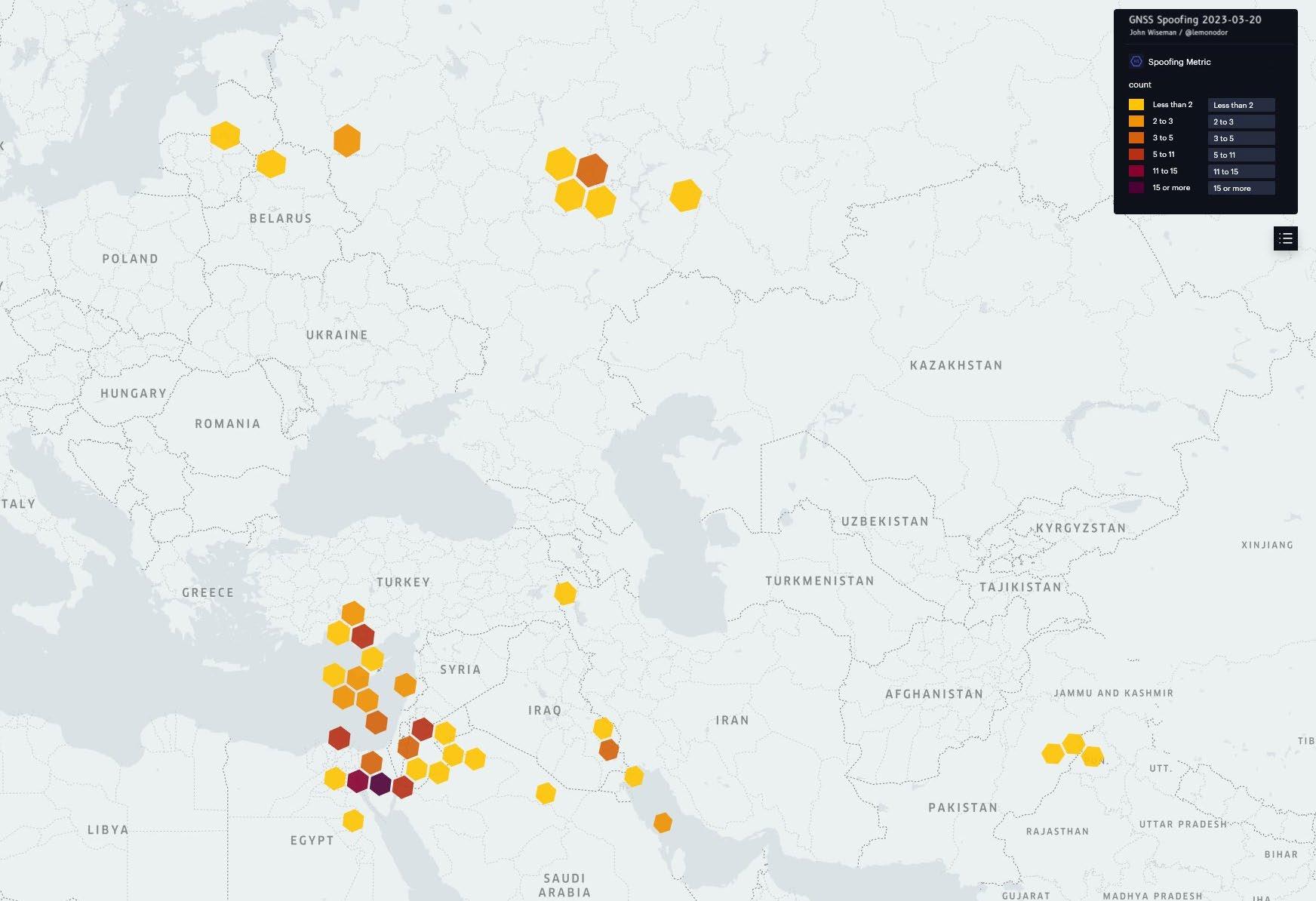



A data-led overview of the emergence of GPS interference as a hazard to air operations to/from, near and over conflict zones as well as areas of increased military activity and a summary of how the airspace environment in these areas has evolved.







A data-led overview of the emergence of GPS interference as a hazard to air operations to/from, near and over conflict zones as well as areas of increased military activity and a summary of how the airspace environment in these areas has evolved.



GPS interference typically occurs in two main ways: jamming or spoofing of the signal GPS jamming is the interference on frequencies from external sources and it can cause the receiver to lose the position information. GPS spoofing happens when fake GPS signals interfere with a receiver and thus deceive users by displaying false locations or times

Osprey:Explore Data Analytics on GPS Interference Globally


GPS interference refers to any unintentional or intentional disruption of the Global Positioning System (GPS) signals, which are utilised for navigation, timing, and various other applications. Interference can occur due to a variety of factors: natural causes, man-made interference or physical obstructions.
GPS interference can have significant consequences, especially in critical applications like aviation, transportation, and military operations, where accurate positioning and timing are essential. It can lead to navigation errors, loss of signal lock, or even complete system failure. Therefore, mitigating interference and ensuring the integrity of GPS signals are crucial for maintaining the reliability and safety of GPS-dependent systems.
One of the first indications of a loss of GPS will be the synthetic vision reverting to the basic blue-over-brown mode. Other indications may include:
• GPS position is blanked out
• GPS mode goes to ACQUISITION from the normal NAVIGATION modes
• The FMS degrades to other available sensors for positions like IRS, DME/DME or VOR/DME
• As this degradation occurs the EPU will increase to that of the next sensor
• ADS-B is unable to broadcast a GPS position
• CHECK GPS X POSITION (FMS and GPS position differ)
• CHECK IRS X POSITION (FMS and Pure IRS position differ)
• CHECK VORDME X POSITION (FMS and IRS position differ)FMS – GPS POS DISAGREE
• FMS 1-2-3 GPS MISCOMPARE
• DEGRADE Indication
• UNABLE RNP (when EPU exceeds the RNP of the current flight path leg)
• UNABLE RNP NEXT WPT (when EPU is expected to exceed the RNP of the next flight path leg)
• ADS-B FAIL/ATC ADS-B TRANSMITTER FAIL
There may be additional indications and/or different messages that vary by OEM. For more information please visit: https://aerospace.honeywell.com/us/en/about-us/blogs/spoofing-and-jamming


GPS jamming is the interference on frequencies from external sources and it can cause the receiver to lose the position information

Key impacts to operations
1. Navigation Disruptions
2. Flight delays and diversions
3. Safety concerns
4. Increased workload for pilots
5. Security concerns
6. Financial impacts
GPS jamming emanating from armed conflict and/or military activity in recent years: Mexico, Colombia, Venezuela, Afghanistan, India, Pakistan, Armenia, Azerbaijan, Iran, Iraq, Israel, Lebanon, Syria, Cyprus, Jordan, Libya, Egypt, Saudi Arabia, Bahrain, Qatar, UAE, Kuwait, South Korea, North Korea, Taiwan, Russia, Ukraine, Moldova, Romania, Poland, Finland, Sweden, Lithuania, Latvia, Estonia & Turkey
Overwater Areas: Yellow Sea, Bohai Gulf, South China Sea, Eastern Mediterranean Sea, Gulf of Aqaba, Red Sea, Gulf of Aden, Persian Gulf, Strait of Hormuz, Gulf of Oman, Barents Sea, Baltic Sea, Black Sea, Caspian Sea & Aegean Sea
GPS Jam Org: https://gpsjam.org/
FlightRadar24: https://www.flightradar24.com/data/gps-jamming
RadarBox: https://www.radarbox.com/gps-accuracy


GPS spoofing happens when fake GPS signals interfere with a receiver and thus deceive users by displaying false locations or times
Key impacts to operations
1. Navigation misguidance
2. Increased risk of accidents
3. Compromised safety
4. Operational disruption
5. Financial losses
6. Security risks

GPS spoofing emanating from armed conflict and/or military activity in recent years: Niger, China, Armenia, Azerbaijan, Iran, Iraq, Israel, Lebanon, Syria, Cyprus, Egypt, Saudi Arabia, Bahrain, Qatar, UAE, Kuwait, Russia, Ukraine, Belarus, India, Pakistan & Turkey
Overwater Areas: Bohai Gulf, Eastern Mediterranean Sea, Gulf of Aqaba, Red Sea, Bab elMandeb Strait, Gulf of Aden, Persian Gulf, Strait of Hormuz, Gulf of Oman, Black Sea & Baltic Sea
Public Tools
GPS Spoofing Tracker: https://spoofing.skai-data-services.com/
APG NaviGaurd: https://flyapg.com/products/naviguard
Honeywell: https://aerospace.honeywell.com/us/en/about-us/blogs/inertial-referencesystems-and-gps-spoofing-honeywell-sets-the-record-straight


US: https://www.faa.gov/other_visit/aviation_industry/airline_operators/airline_safety/safo/all_safos/SA FO24002.pdf
EASA SIB: https://ad.easa.europa.eu/ad/2022-02R2
IATA Support: https://www.iata.org/en/pressroom/2024-releases/2024-01-26-01/
US DoT NAVCEN: https://www.navcen.uscg.gov/gps-problem-report-status
US CISA PNT: https://www.cisa.gov/topics/risk-management/positioning-navigation-and-timing
US DHS PNT: https://www.dhs.gov/science-and-technology/pnt-program
Honeywell: https://aerospace.honeywell.com/us/en/about-us/blogs/spoofing-and-jamming



Effective mitigation strategies, including improved detection and countermeasures, are essential to minimise the risks associated with GPS jamming in aviation. Robust countermeasures and vigilance are necessary to mitigate the risks associated with GPS spoofing in aviation.
Operators are advised to review internal and external mechanisms for suspicious activity, safety and security reporting. Any revisions to processes should account for such disruption as part of a wider aviation risk management strategy. Operators are advised to monitor government advisories as well as trends in GPS interference tactics, such as the employment and proliferation of electronic warfare systems.
Aviation operators should monitor airport/airspace-specific NOTAMs, bulletins, circulars, advisories, prohibitions and restrictions prior to departure to avoid flight schedule disruption. In addition, ensure crews scheduled to operate over the areas discussed in this presentation in the near term are fully aware of the latest airspace safety situation.
Osprey advises operators to remain prepared to conduct flights over the areas discussed in this report without GPS navigational systems and conduct enhanced monitoring of onboard systems that utilise GPS.

(01 Aug 23 – 01 Feb 24)


Ensure flight plans are correctly filed in advance of all operations
Attain proper special approvals for flight operations to sensitive locations
Ensure to obtain all relevant overflight permits before departure
Security and operational risk-based identification of pre-planned divert airports
Defer diverting from flight plan except for life-threatening situations
Ensure adequate fuel onboard in case of being placed into a holding pattern by ATC
Remain in regular contact with ATC during the duration of flight
Operate with applicable transponders, including ADSB
Evaluate use of IATA Inflight Broadcasting Procedure (IFBP)
Evaluate the use of Traffic Information by Aircraft (TIBA) procedures in ICAO Doc 7030
Reliable and redundant communications with an established communications plan
Fully coordinated and robust emergency response plan supplemented by asset tracking
Reliable source of information on where GPS interference is occurring
Prior to flight, ensure accurate filing of flight plans, obtain necessary approvals for sensitive areas, and secure overflight permits. Identify pre-planned divert airports based on security and operational risks. Only divert in life-threatening situations. Maintain fuel reserves for potential holding patterns. Stay in contact with ATC, use transponders, and evaluate broadcasting and traffic information procedures. Establish reliable communication and emergency response plans, including tracking assets and monitoring GPS interference.
If you want to find out more about how we developed this assessment and our leading aviation risk assessment products that you can use to gain a better understanding of the risk facing your flight operations, please get in contact today.


